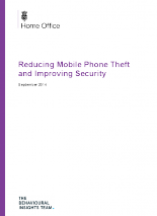The independent Crime Survey for England and Wales shows crime at its lowest level since the survey started in 1981. While the overall downward trend is encouraging, the level of mobile phone theft remains a concern. There were around three quarters of a million victims of mobile phone theft in England and Wales in the year 2012/13. Almost 100,000 of these thefts took place in London alone.
Following analysis of results from the Crime Survey for England and Wales, and by examining hundreds of thousands of data points detailing mobile phone thefts in London (for the period of 1 August 2012 to 5 January 2014 – the latest data available to us), we have produced the most detailed evidence yet on how and when mobile phones are stolen, and who is most at risk.
The data showed that victims of mobile phone theft are likely to have had their phones stolen directly from their person (e.g. through pickpocketing) or when the handset was momentarily left unattended (e.g. from a table in a bar). The data also showed that certain groups of people are especially vulnerable: 14-24 year olds, and particularly women, are more likely than any other group to be the victim of mobile phone theft. The richness of the London dataset provided by the Metropolitan Police also enables us to see which types of phone were most likely to be stolen.
Both types of data – on which phones were more likely to be stolen and in which situations people are most likely to be vulnerable to phone theft – can help to inform the public, and so play a part in the wider programme of work being conducted by the police to tackle mobile phone theft.
We hope that this paper will lead the mobile phone industry to continue to help consumers use their products even more safely, and to make the existing security features more obvious and simpler to use for consumers.
